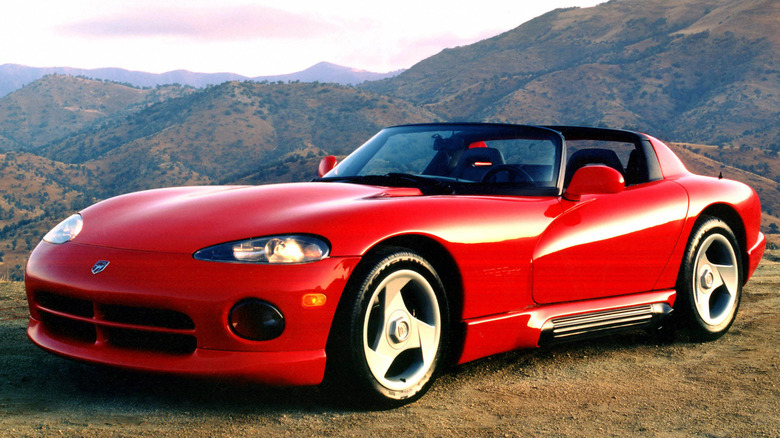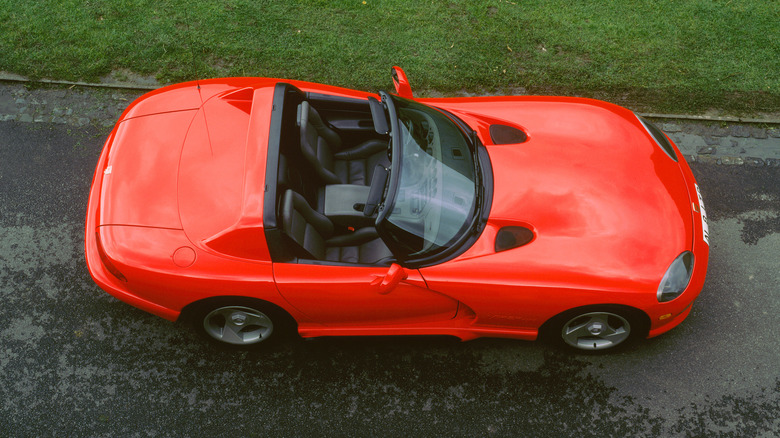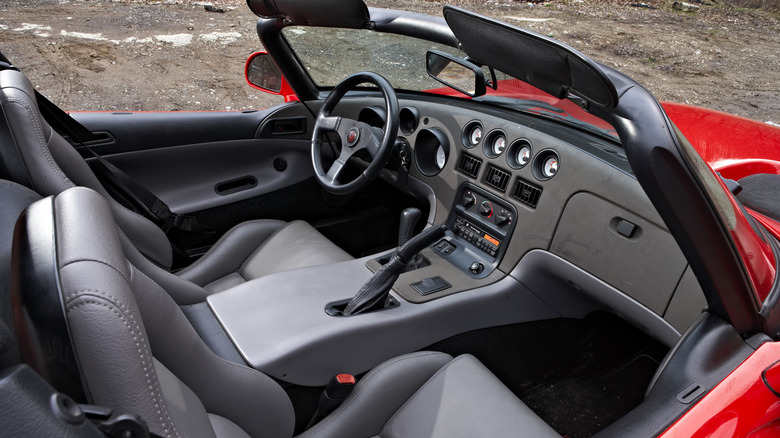The First Dodge Viper Was So Wild It's Hard To Believe They Built It
Words like "polished" and "refined" don't exactly fit within Dodge's vocabulary when it comes to performance cars. Competing brands like Ford and Chevy likely use a series of scientific tests, focus groups, and manufacturing know-how to make cars like the Shelby Mustangs, supercharged variants of the Camaro, and whatever new edition of the Corvette is on the horizon. Dodge, on the other hand, doesn't look like it takes that same measured approach to making the latest and greatest cars. Cars like the Hellcat variants of the Charger and Challenger look like they spent all of fifteen seconds on the drawing board — and the only note was "be fast." The brand has spent the last several years supercharging its entire lineup like it just bought an entire freight train of superchargers and needs to get rid of them right now.
That all-nonsense approach has worked extremely well for Dodge. As both the Dodge Challenger and Charger ride off into the sunset (avoiding any telephone poles), the Hellcat has left a permanent mark on automotive culture. For good or ill, everyone is now watching their rear-view mirror for a Hellcat. But long before the Hellcat's supercharger ever spooled up and scared an entire neighborhood, Dodge had the Viper: A car that started out so barebones and insane, that it's a marvel it was even produced.
Just the bare minimum for speed
The first Dodge Viper from the early 1990s was quite possibly one of the wildest cars to come from a major manufacturer. It looks like it was built by someone in their garage, and not from the same company that invented the minivan just a few years prior. Right from the factory, the 1992 Dodge Viper R/T 10 had no side windows. That's not a mistake from Dodge or an option for racing, it just didn't have any. It lacked a proper roof, too. It was only a thin layer of hubris between the driver and the wild blue yonder. It did come with a sheet of canvas to drape on top of the car in case the driver was caught in the rain. But driving in the wet was probably not a great idea in the Viper, as it didn't have anti-lock brakes or traction control. You do have a radio, so at least there's that (via Car and Driver).
The real cause of the Viper's insanity was its powerplant: An 8-liter V10 that would look more at home in a World War 2 fighter plane than a sportscar — which didn't even have AC. It produced over 400 horsepower, and in 2022, 400 doesn't seem like a lot. 30 years ago, 400 horsepower meant you were the apex predator. That predatory power was rare, too, as Dodge made just 285 Vipers during the first year of production (via MotorTrend).
Safety not included for the Dodge Viper
"Spartan" doesn't even begin to describe the interior of the Viper, as it looks like just slightly nicer than some folding chairs. Inside the Viper is the only place you'll find door handles and locks, as the outside doesn't have door handles because something as pedestrian as handles would betray the Viper's curves going in every direction. Straight out of 1965, the Viper features side-exit exhausts that Car and Driver notes will burn you if you aren't careful.
It's easier to list the safety features the Viper did have than the features it didn't have. Those features are as follows: seat belts, and the driver's own will to live. Despite the Viper's total lack of creature comforts, the Viper was surprisingly compliant when driving, provided you knew what you were doing. Reviews from the time note that the Viper wasn't totally an unhinged monster when you drove in a sane manner. Turns out that a gargantuan V10, a tube steel frame, and tires wider than what was thought to be theoretically possible, makes for a good combination.


